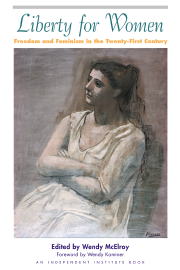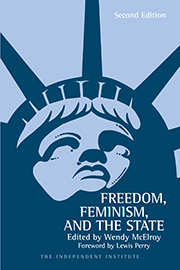In commenting on the World Trade Organizations (WTO) riots in Seattle, The Economist asked, “Why were there no anarchists among all those ‘anarchists?’” Actually, there were, but the ones drawing attention were the sort who give overthrowing the State a bad name. Salon (almost alone among the media) was more accurate in stating: “Most reports simply labelled the rioters ‘anarchists,’ missing the fact that many among the peaceful blockaders consider themselves anarchists, too.”
Clearly, some definition is necessary. The self-proclaimed anarchists who proceeded to “direct action at the point of consumption” (translation: smash windows and loot) were left anarchists. They were attacking an abstraction—the free market—by destroying the specific property of individual shop owners. The owners were guilty of wrongdoing because, well, they were “owners.”
This is not American anarchism. Individualist anarchism, the indigenous form of the political philosophy, stands in rigorous opposition to attacking the person or property of individuals. The philosophy revolves around the “Sovereignty of the Individual”—as an early champion, Josiah Warren, phrased it. Whether you prefer the term “self-ownership” or “the non-invasion principle,” the core of the philosophy remains the same.
The idea is that every peaceful individual must be at liberty to dispose of his person, time, and property as he sees fit. Force is permissible only in self-defense and only when directed at the offending individual(s), not at the representatives of a class. Individualist anarchism rejects the State because it is the institutionalization of force against peaceful individuals.
Left anarchism (socialist and communist) are foreign imports that flooded the country like cheap goods during the 19th century. Many of these anarchists (especially those escaping Russia) introduced lamentable traits into American radicalism. They believed in “propaganda by deed”: that is, the use of violence as a political weapon and a form of political expression.
They also divided society into economic classes that were at war with each other. Those who made a profit from buying or selling were class criminals and their customers or employees were class victims. It did not matter if the exchanges were voluntary ones. Thus, left anarchists hated the free market as deeply as they hated the State.
By contrast, individualist anarchists demanded that all voluntary exchanges be tolerated, if not respected.
For better or worse, the two schools of anarchism had enough in common to shake hands when they first met. To some degree, they spoke a mutual language. For example, they both reviled the State and denounced capitalism. But, by the latter, individualist anarchists meant “state-capitalism” the alliance of government and business. As a solution to such “capitalism,” they called for measures such as free banking. In other words, they wanted to set up voluntary and more effective alternatives. And if such a voluntary society still harbored such evils as exorbitant interest rates.so be it. No one had the right to intervene in a non-coerced exchange. Not even a well-intentioned anarchist.
The ideological honeymoon was soon shattered. A major conflict was over the left’s use of violence as a political strategy. For example, in March 1886, Benjamin Tucker—editor of Liberty, the voice of 19th century individualist anarchism—caused a national scandal. He published an article entitled “The Beast of Communism.” There, he disclosed that “a large number” of communist anarchists in New York City were setting fire to their own property to collect on capitalist insurance policies, even though some properties were tenements with hundreds of occupants. In one fire, a mother and her newborn had burned to death. Tucker labeled these so-called radicals as “a gang of criminals.”
Individual and left anarchists were fellow travelers no more. Liberty became a foremost critic of left magazines like Freiheit, which ran articles on the virtues of dynamite and instructions on how to produce nitroglycerine.
The schism between the two forms of anarchism has deepened with time. Largely due to the path breaking work of Murray Rothbard, 20th century individualist anarchism is no longer inherently suspicious of profit-making practices, such as charging interest. Indeed, it embraces the free market as the voluntary vehicle of economic exchange.
But as individualist anarchism draws increasingly upon the work of Austrian economists such as Mises and Hayek, it draws increasingly farther away from left anarchism.
Occasionally, there are issues upon which the left and right can unite in protest. Opposition to the WTO could have been one of them. But not because the organization is an expression of “free trade.” The WTO has nothing to do with free trade. Some nation members want tariff preferences for developing countries. Japan wants to protect its fishing and forestry. Switzerland intends to maintain subsidies for farmers. The EU wants to restrict certain imports (e.g. beef) until the technology (e.g. genetic modification) can be “proven” safe.
Meanwhile, Clinton demands a standing forum for discussion between the WTO and ILO so that Democrats won’t alienate the labor vote in the upcoming election. All in all, the spirit of the WTO is captured by the EU trade commissioner, Pascal Lamy, who believes that free trade should be “controlled, steered and managed according to the concerns of EU citizens.” This is a definition of “free trade” with which I am unfamiliar.
True free trade means the same thing as it did to Legendre, the businessman reputed to have provided a famous answer to the 17th century French politician Colbert, who wanted to know how to assist him. Legendre is said to have replied, “Laissez nous faire”—leave us alone.
The historian Ralph Raico explains, “Today the term laissez faire has come to mean: leave the people alone, let them be, in their economic activities, in their religious affairs, in thought and culture, in the pursuit of fulfillment in their own lives.“ This is what the free market means to individualist anarchism.
Left and right anarchists could have united in non-violent protest against the WTO as a vehicle of government oppression. But instead of smashing the State, left anarchists smashed the windows of shopkeepers. As it stands, there are only two things about Seattle on which left and right can agree. For whatever reason, the WTO must go. And at least neither one of us is the police.









